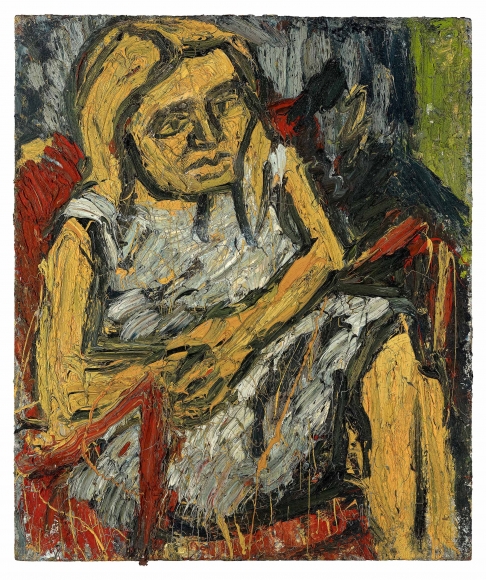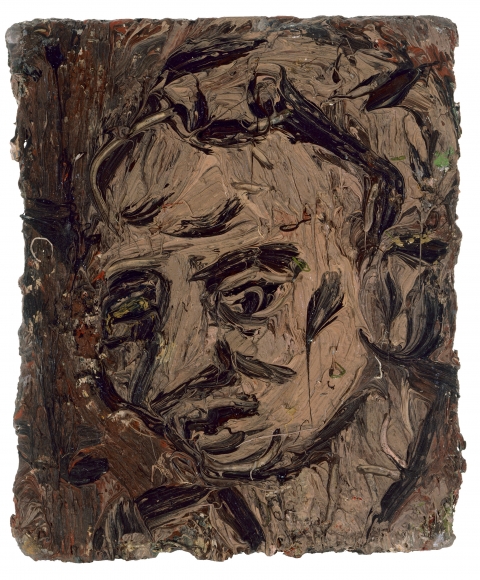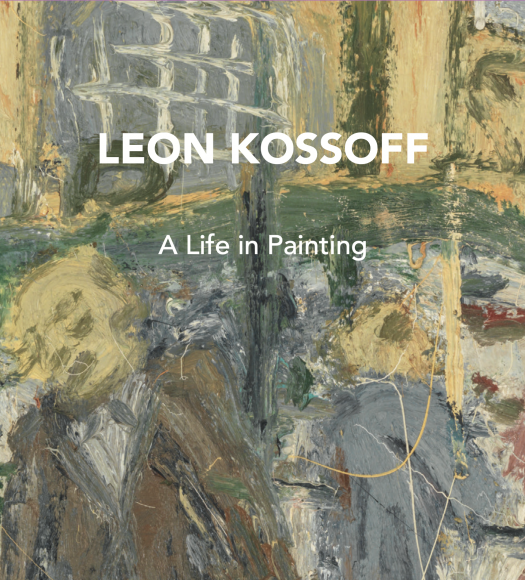Mitchell-Innes & Nash, Annely Juda and L.A. Louver have announced Leon Kossoff: A Life in Painting, a major touring retrospective of paintings by seminal British artist Leon Kossoff (1926 – 2019) that will open in London in September 2021 and travel to New York and Los Angeles in January 2022. Comprising 58 works, this touring show will be the first posthumous and largest exhibition of Kossoff’s paintings in a commercial setting to date, and coincides with the publication of Leon Kossoff: Catalogue Raisonné of the Oil Paintings by Modern Art Press. The exhibition is curated by Andrea Rose, former Director of Visual Arts at the British Council and editor of the catalogue raisonné.
LEON KOSSOFF
Portrait of Rosalind No. 1
1973
Oil on board
57 by 48 in. 144.8 by 121.9 cm.
Leon Kossoff: A Life in Painting will be the third collaborative exhibition of works by Leon Kossoff organized in partnership between Mitchell-Innes & Nash (New York), Annely Juda Fine Art (London), and L.A. Louver (Venice, CA). Previous traveling exhibitions co-presented by the three galleries include Leon Kossoff: Recent Works 1999 - 2010 (2010-2011) and Leon Kossoff: London Landscapes(2013-2014).
EON KOSSOFF
Self-portrait
1974
Oil on board
9 3/4 by 8 in. 24.8 by 20.3 cm.
For the New York leg of the traveling exhibition, Mitchell-Innes & Nash will present 16 paintings by the artist, ranging in date from 1963 to 1993.
Leon Kossoff is recognised as one of the world’s greatest Post-War figurative painters with an appreciation of life’s everyday activities, finding poignancy and beauty in seemingly mundane urban settings. Born to a family of Jewish immigrants from Ukraine in Central London, his childhood was centered in his working-class experiences helping with his father’s bakery, and then serving in the British military in the 1940s. Following his return to London, Kossoff attended St. Martin’s School of Art, though he supplemented his studies attending David Bomberg’s classes at Borough Polytechnic, where he was instructed to focus on experiences rather than just appearances.
Together with the artists Francis Bacon, Lucian Freud, Frank Auerbach, Michael Andrews, and R.B. Kitaj, Kossoff became known in the late 1970s as part of the “School of London.” Having lived his lifetime in London (from which he rarely traveled), his paintings of his native city are rendered with the familiarity of a close friend. Complicated, sometimes bleak, but always vital and teeming with activity, Kossoff’s paintings reflected London’s transformation, stretching from post-war desolation to international affluence towards the end of the 20th century.
“What makes Leon’s works so singular, and indeed so contemporary, is that they give new life to the notion of representational painting,” said exhibition curator and editor of the catalogue raisonné Andrea Rose. “We see in them the interplay between external reality and internal perception freshly achieved. Kossoff doesn’t just perceive the world around him, he regenerates it. There’s a thrill to it, the ordinary made momentous. ‘Perhaps’, as he said, ‘everything is beautiful.’”
Spanning sixty years, Leon Kossoff: A Life in Painting casts light on some of the key moments in Kossoff’s career. From post-war bomb and construction sites, to crowded swimming pools, churches, Underground stations and the restless bustle of street life, the paintings passionately chart over half a century of change and development, mostly centered by the London neighbourhoods of Dalston, Willesden, Kilburn and Whitechapel. What makes Kossoff’s paintings so contemporary is their interplay between observed reality and imaginative zeal, where, according to Kossoff, “all the differences amount to a sort of presence.”
The exhibition concludes with some never-before seen paintings of the Arnold Circus area and Kossoff’s own back garden. In addition to London landscapes, the exhibition includes portraits of the painter’s mother and father, his wife Peggy (also known as Rosalind), the writer N. M. Seedo, his painter friend John Lessore, his faithful sitters Fidelma, Pilar and Cathy, as well as several self-portraits. In all these works, Kossoff searches for a way to bring myriad experiences together in a single image, every brushstroke telling the story of doubt and opportunity that went into their making, all of them threatening to dissolve into fleeting abstraction at any given moment. “That’s what all painting is about,” said Kossoff in a rare interview in 2010. “It’s space and light occupied by human presences.”
Biography
Born in 1926, Leon Kossoff has been described as one of the greatest British artists of his time. For a little over seventy years, the changing face of London’s urban landscape has been a recurring subject of his work, and he would return to familiar sites such as King’s Cross station, Christ Church at Spitalfields and the neighborhoods of Dalston, Kilburn and Willesden, among others.
Apart from capturing the immediate precincts of his home and studio, Kossoff was also known for his portraits. His subjects were mostly members of his own family, close friends and a small number of models of long acquaintance. These works are deeply moving evocations of the human presence. He was an artist who enjoyed working directly with his material and his paintings are known for their thickly layered, almost sculptural surfaces.
Along with Francis Bacon, Lucian Freud, Frank Auerbach and R.B. Kitaj, Kossoff was part of the group of figurative painters known as the School of London that came to prominence in the 1970s. Kossoff’s work has been included in numerous solo museum exhibitions, including the Museum of Modern Art Oxford (1981); the Tate Gallery, London (1996); the J. Paul Getty Museum, Los Angeles (2000); the Los Angeles County Museum of Art (2000); the National Gallery of Australia, Canberra (2001); the Metropolitan Museum of Art, New York (2000); the Louisiana Museum of Modern Art, Humlebaek (2004); the Museum of Art Lucerne (2004); and the National Gallery, London (2007). In 1995, Kossoff was chosen to represent the British Pavilion at the 46th Venice Biennale.
Related Publications
In an image provided by the artist’s estate, Leon Kossoff’s “Between Kilburn and Willesden Green, Winter Evening” (1991). Kossoff’s life and works are being celebrated in a show coordinated across three galleries: Mitchell-Innes & Nash in New York, Annely Juda Fine Art in London and L.A. The Leon Kossoff Estate and Mitchell-Innes & Nash, New York via The New York Times.
The exhibition coincides with the forthcoming 30 September 2021 release of Leon Kossoff: Catalogue Raisonné of the Oil Paintings, the comprehensive 642-page account of the artist’s paintings, edited by Andrea Rose and published by Modern Art Press, London. Great review here.
Additionally, a fully illustrated 120-page exhibition catalogue, titled Leon Kossoff: A Life in Painting, will be co-published by Annely Juda Fine Art, Mitchell-Innes & Nash and L.A. Louver, and will be available through the three galleries upon request.




